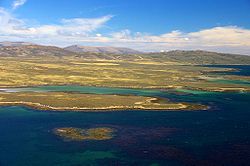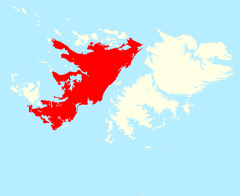West Falkland
| West Falkland | |
 West Falkland, near Keppell Island | |
|---|---|
| Main settlement: | Port Howard |
| Location | |
| Location: | 51°47’51"S, 60°7’55"W |
| Area: | 1,750 square miles |
| Highest point: | Mount Adam, 2,300 feet |
| Data | |
| Population: | 144 (2001) |
West Falkland is the second largest of the Falkland Islands in the South Atlantic. It is a hilly island, separated from East Falkland by Falkland Sound. Its area is 1,750 square miles and its coastline is 782 miles long.
The coast is deeply indented with sea-lochs, particularly on the storm-battered west coast.
Population
The island has fewer than 200 people, scattered around the coastline. The largest settlement is Fox Bay on the east coast. Other farmsteads include Port Howard, Albemarle, Chartres, Dunnose Head, Hill Cove, Port Stephens, and Roy Cove, most of which are linked by road and also have airstrips and harbours. In 1986, the population was 265, in 2001, it had fallen to 144.
The whole of West Falkland is termed part of the "Camp", a Falklander term for the area outside Stanley.
Geography and wildlife
West Falkland is more hilly on the side closest to East Falkland; the principal mountain range, the Hornby Hills, runs north and south parallel with Falkland Sound. Mount Adam, the highest hill in the islands, is 2,300 feet above sea level, almost as high as the "territory top" on its neighbour island.
Once it was thought that Mount Robinson at 2,280 feet above sea level was the island's highest point, until a later survey found that Mount Adam was higher.
The major industry on the island is sheep farming, while it is also known for its penguin and cormorant colonies. Fishing is also popular in the two main rivers, the Warrah and the Chartres.
In the 19th century as today, indigenous land fauna was very scanty. A small wolf, the warrah, the loup-renard of Louis Antoine de Bougainville, is extinct, the last having been seen about 1875 on West Falkland. It is commemorated in the name of one of the island's rivers, the "Warrah". Some herds of cattle and horses ran wild; but these were introduced by settlers as were the wild hogs, the numerous rabbits and the less common hares. All these have greatly declined in numbers, being profitably replaced by sheep.
The southernmost point of West Falkland is Cape Meredith, and the most south-westerly point is Calm Head. On the southerly side lie high cliffs with an abundance of seabirds. To the west are some white sandy beaches with beautiful clean water and rolling sand dunes with tall grass. Set just back from the top of the cliffs is a single wooden hut locally referred to as Uncle Tom's Cabin. The beaches are a habitat for elephant seals and are unpolluted save for the occasional piece of wreckage and the odd washed-up tree trunk.
Geology
Most of the layers of West Falkland and its surrounding islands are slightly inclined from the horizontal. This inclination shows different types from rocks in different places. The quartzites of Port Stephens and Stanley are more resistant than the arenaceous sediments of the formation at Fox Bay. The Hornby Mountains, near Falkland Sound have experienced tectonic forces of uplift and folding by which the quartzite beds of Stanley are inclined to the vertical.
In West Falkland there are several dykes that cut the rocks of the western islands, but these dykes, unlike the previous ones, are chemically more unstable and have been eroded. The only indications of their existence are the aligned linear depressions. In the margins of these depressions there is evidence of contact baking or hornfels formation adjacent to the once molten basalt dyke.
History
Early explorers reported the remains of Indian canoes on West Falkland but it is unclear whether it was a one way trip, or indeed if the canoes were not swept in from Patagonia.
Captain John Strong of the Welfare made the first recorded landing on either of the main islands (West and East Falkland) on 29 January 1690 at Bold Cove on the other side of the headland from Port Howard. He said:
Wednesday this morning we weighed and stood unto an harbour on ye west side and there came to ane anchor and sent our boat on shoar for fresh water and did kill abundance of geese and ducks but as far as wood there is none.
The lack of wood is somewhat surprising, as while there were no trees growing there, driftwood frequently washes up on Falkland beaches. This may be accounted for by the sheltered nature of Bold Cove. Strong named Falkland Sound, which gave its name to all the islands.
While the first recorded landing on the main islands of the Falklands was on West Falkland, it was settled remarkably late. In 1867 there were no settlers on West Falkland. The government issued a proclamation offering leases of grazing stations on very moderate terms and in 1868 all the available land was occupied.
Modern West Falkland is also home to two |RAF Reporting Posts: Mount Alice, which is near Port Albermarle in the south of the island, and Mount Byron in the north.[1]
In early 2007 the Falkland Islands Government awarded a contract to supply an East-West ferry to Workboat Services Ltd.[2] The service runs between Port Howard and New Haven.
Falklands War
West Falkland saw some activity during the Falklands War in 1982; Fox Bay, Port Howard and Pebble Island were all occupied by Argentine forces during the hostilities and were subjected to occasional British naval bombardment and air attacks.
The most significant skirmish on West Falkland was perhaps the skirmish at Many Branch Point, near Port Howard.
Shag Cove saw several Argentine helicopters downed after British Harrier jump jets attacked them. The raid on Pebble Island has gone down in British Special Forces history.
References
- ↑ "RAF Today". [United Kingdom] Ministry of Defence. 02/2004. http://www.raf.mod.uk/downloads/documents/raftoday2004.pdf. Retrieved 24 July 2010.
- ↑ "Workboat Services Ltd (Home page)". http://www.workboat.co.fk/index.htm. Retrieved 3 May 2010.


